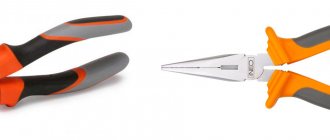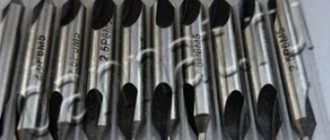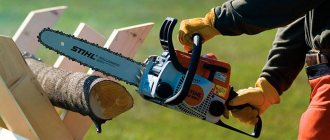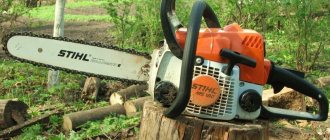Pincers and forceps are the most ancient devices known since prehistoric times. According to historians, they were initially used in blacksmithing, but very quickly formed a large group of pliers. Today, the number of varieties of such devices is very large; not every master can list them all at once. They are usually called pliers or pliers, although almost every design option has its own name.
It is noteworthy that significant changes in the design of such instruments have not been made for a very long time, despite noticeable changes in the appearance of other devices. In addition, the specific use does not imply the creation of a power tool from these devices. Let's take a closer look at them.
What are pliers and pliers?
1-Pliers 2-Pliers
Both types are the most common and extensive types of pliers. They all have a similar design - two identical (most often) elements connected by a hinge. On one side there are handles, the other part is the working part.
The difference between all types consists of two positions:
- Sponge shape . This indicator determines the name and purpose of the tool.
- Hinge type . The classic type is a fixed hinge, but detachable options are often found that allow you to change the size of the working base (the grip width of the jaws).
The purpose of the tool is determined by the shape of the jaws. It can have cutting edges, cutouts that provide a stronger and tighter grip, and form a kind of template for bending various parts.
The following varieties exist:
- Pliers.
- Pliers.
- Wire cutters.
- Side cutters.
- Round nose pliers.
- Long nose pliers.
- Needle nose pliers.
- Ticks.
Expert opinion
Levin Dmitry Konstantinovich
In everyday life, any type of tool at the disposal of a craftsman is often called pliers. This is wrong, but it is not important for a home master. However, when communicating between specialists or in a store, you should be precise and understand the differences between the tools.
Features of pliers
There are three important features worth mentioning that make pliers such a practical tool:
- Grippers for holding various materials;
- The cutting edge is located in the lateral plane between the jaws and the handle;
- Comfortable non-slip handle provides a secure grip in a variety of situations.
Difference between pliers and pliers
The difference between both types is not fundamental, but quite definite.
Pliers are designed for gripping, squeezing, and bending various parts or workpieces. The working surfaces are straight, usually with fine corrugation to prevent the material from slipping when gripping.
Pliers are a universal tool. They are capable of performing a significantly larger number of operations and tasks, since their jaws are equipped with various recesses, grips, and cutting edges on both the inside and outside.
A typical set of functionality typical of pliers:
- Capturing, clamping parts.
- Bending wire or sheet metal.
- Biting wire, nails, screws, etc.
The versatility of pliers makes them the main type of pliers. They are used by electricians, mechanics, technicians, and other specialists. Due to their capabilities, they are included in the mandatory set of tools and devices required to perform most technical or construction tasks. Often pliers are equipped with additional tools - a grip on the other side of the hinge, auxiliary devices at the ends of the handles (screwdriver or awl). The demand and popularity of the instrument is confirmed by the large selection of manufacturers and models available on store shelves.
Pliers are an indispensable tool
Pliers are one of those hand tools that cannot be replaced in a home workshop. Their versatility means they can be used in a variety of situations - most often when you need to hold or cut something.
Like most popular hand tools, pliers come in specialized varieties. These differences are especially noticeable if you look at the photo of the pliers. The multitude of design options is simply amazing.
However, such originality of shapes is made for practical reasons - different pliers are designed for different jobs.
When planning to purchase a tool, you should choose it in accordance with your needs.
Features, technical specifications
The main technical characteristics of pliers and pliers are:
- Size (total). Usually ranges from 10 to 20 cm.
- Width of jaws. standard - 2-3 cm.
- Opening angle of working surfaces. Depends on the type of hinge and specific design features.
- Set of functions (for pliers). The presence of cutting surfaces, the ability to cut through steel wire using a groove on the outer surface of the jaws, a return spring, etc.
- Hinge type. There are fixed or adjustable designs
- Availability of rubber, PVC or plastic linings for handles
- View
- Coatings: Tools are available in chrome or blued finish.
The main feature of the tool is the presence of two handles that perform dual functions:
- Used for holding in hands.
- Adjust the amount of opening and compression force of the jaws.
Expert opinion
Levin Dmitry Konstantinovich
Working with insulated handles allows you to protect yourself from electric shock and provides comfort when using the tool in severe frost. However, there are pliers and pliers that do not have additional elements. They are usually used for working with hot objects when the safety of the handles cannot be ensured. In such situations, hand protection is necessary - mittens, suede gloves, etc.
Pros and cons of the tool
The advantages include:
- Multifunctionality, versatility of use, ability to perform various tasks.
- Compact, light weight, easy to carry the tool with you.
- Wide choice of size, shape, additional functionality.
- Affordable price.
Flaws:
- The metal is prone to corrosion, so it is necessary to organize appropriate conditions for storing the tool.
- The fixed hinge is subject to loss of mobility and requires periodic lubrication.
- The handles wear out quite quickly and require replacement.
The disadvantages can be considered design features, since they are equally inherent in all pliers. The high demand and demand for pliers and pliers is well confirmed by the presence of one or several copies for every specialist and home craftsman.
Criterias of choice
You can choose a high-quality and convenient tool based on the following criteria:
- Purpose, main tasks to be solved. Determine the size and width of the sponges, check the comfort of the hand grip and other organoleptic indicators;
- Set of functions. For electricians, it is important to have insulating pads on the handles. In addition, it is necessary to inspect the working part and find out what operations are available when using this instance. It is recommended to choose the most multifunctional tool possible, although some additional functions may be redundant;
- The color of the handles should be bright enough so that you can immediately find them in low light conditions;
- The tool manufacturer must be well-known and reliable. There are a large number of products from Southeast Asian countries on the market. They do not provide sufficient strength and are made from the wrong steel. Sometimes the handles or jaws of such specimens simply break during operation. It’s better to pay more, but get a high-quality and durable tool;
- There are household and professional pliers. The first ones are produced for home use, are not durable and are intended for occasional use. The latter are noticeably more expensive, but fully meet all quality requirements. It is recommended to give preference to professional samples that are guaranteed to perform all available tasks;
- It is necessary to check the tool by squeezing the handles. Ideally, the jaws should compress tightly, without gaps. The cutting edges are adjacent to each other. The movement of the jaws is soft, without resistance.
Expert opinion
Levin Dmitry Konstantinovich
You should not save on buying a tool. The result will be the need to soon go to the store again and spend money again, so it is better to immediately choose a high-quality copy, even if it is somewhat more expensive than other varieties.
What is the difference between pliers and pliers?
Both tools are of the pliers type and have extremely similar characteristics in appearance, while they differ from each other in GOST standards and production technology.
Pliers get their name from the flat shape of the jaws, which fit tightly together, and are originally designed only for gripping and holding small parts.
Pliers are a more modern tool, therefore they are universal.
Due to the presence of cutting elements and grooves on the lips, in addition to the functions of pliers, they can also perform others, for example: holding round parts.
Pliers are also used for cutting wire products, stripping wires, and can partially serve as a wrench, side cutter and stripper, depending on the configuration.
The main difference is considered to be that the pliers do not have additional notches with notches on the lips.
It should be noted that modern pliers also have many different configurations designed to perform different types of work.
Therefore, by and large, pliers and pliers are essentially the same tool, which everyone calls it as it suits them.
Popular makes and models
The number of manufacturers producing various types of pliers is very large. When purchasing, you may find yourself in a situation where all offers are of good quality and functionality.
Let's consider several popular models:
KNIPEX KN-0306160
A tool with dielectric pads that can withstand voltages up to 1000 V. The shape of the jaws is narrowed towards the end to make it easier to work in hard-to-reach places. There are cutting surfaces and a cutout for comfortable grip of round parts.
INFORCE 200 mm 06-18-03
A convenient tool for working with electrical wires. On the cutting edges in the upper part there is a special cutout that keeps the wire itself intact, cutting only the insulation. The large size (20 cm) provides access to terminals or other parts in hard-to-reach places.
NWS CombiMax 180mm, C5.2, H2.2, K12
An excellent choice for installers of metal containers, panel elements and other work with threaded fasteners. The side cutters are combined with a special gear-type crimp that securely holds the bolt head. Comfortable handles with a projection for one-handed operation.
Delo Techniki 413160 160 mm
Lightweight and convenient tool with massive stops on the top of the handles to prevent slipping. Optimal for installation work in narrow, hard-to-reach places. Weight is only 150 g. The shape of the jaws is narrow, curved, making it easier to install small elements.
STANLEY CONTROL-GRIP 200 mm
Classic-type pliers with comfortable insulated handles. Manufactured from carbon steel and easy to move. The weight is quite large - 400 g, which is explained by the strength and reliability of the tool.
MATRIX 16906, 200 mm
An optimal and compact example of pliers suitable for any work. They have all the necessary functions and are equipped with a groove for cutting wire on the outer sides of the jaws. Tool weight: 380 g.
NIH 2212-1-20
Pliers, which belong to the group of household tools, but in terms of functionality and quality are practically no different from professional ones. They have high stops on the handles, precise and tight connection of the jaws, and have cutters and a groove for cutting nails or wire. With a large length (20 cm) they weigh only 290 g.
Ombra 400107
A convenient tool with a smooth ride thanks to the abundant lubrication of the hinge. The handle covers have a two-component design with an anti-slip coating on the outside. With a length of 18 cm, the tool weighs 200 g. The side edges can cope with wire up to 3 mm thick.
WEDO 160 mm 41-160/30R7
The pliers are distinguished by precise German assembly, which allows you to securely clamp the thinnest materials. Made from C60 tool steel. The weight of the instrument is 300 g. Among the disadvantages is the relatively high price.
KNIPEX KN-0202180
Expensive professional tool made of tool steel 63 HRS. It undergoes forging and heat treatment, which makes the cutting edges capable of cutting through the hardest materials, even piano wire. In addition, the length of the side cutters allows you to work with cables up to 11 mm thick. Based on test results, it was determined that working with these pliers requires 35% less effort.
It is impossible and impractical to list all the quality tools. The number of offers on the market is too large. When purchasing, you should consult with a consultant who can recommend the most suitable option for existing conditions.
Parameters of Multifunctional Pliers
The following main parameters of multifunctional pliers are distinguished:
- Length. Although at first glance this doesn't seem particularly important, especially since the differences between individual models are small, it is worth choosing a specific length, for example 180mm universal pliers are the cheapest and most commonly used size. You can also easily buy 160 mm or 200 mm pliers. This characteristic is of great importance, first of all, for ease of work, so medium-length pliers are most often chosen.
- Material. Pliers are a tool that is often used to grip hard parts. Therefore, it is important that they are made of high-quality, hard steel that will not be damaged by destruction during use, which can happen very quickly in the case of cheap options.
- Hardened cutting edges. The pliers themselves should be very durable, but the cutting edges are subject to the most rapid wear, so you should pay special attention to them. Usually they are simply made from hardened steel, but in some models the pliers are additionally induction hardened, which makes them stronger. This is important because although hard materials are rarely cut with pliers, the cutting edge itself is quite sharp and will not be difficult to chip if it is soft.
- Insulated handle. This option most often refers to special pliers for electronics. Dielectric pliers are needed not only by electricians. Due to the versatility of using this tool, it is wise to choose not only pliers with a comfortable grip, but also those whose manufacturer has tested them for insulation. The 1000V extreme is a reasonable threshold for most jobs (although the mains is mostly 230V conductive, most tools are considered a safe insulation threshold to protect against four times the voltage).
- Handle processing. All pliers are essentially two-piece tools: the right pliers and left handle are made of one part, the left pliers and right handle are made of another. This, in principle, eliminates the possibility of damaging the tool, but in some models it is possible to “remove” the rubber layer from the handle.
This is especially true when using poor finishing materials, and the ergonomics of the tool suffers from this. It's best to choose pliers with a very durable handle that won't come off on thicker metal.
Tips from experienced users
To increase the service life of the tool, you should not use it for unusual work. Sometimes pliers are used as a stand when riveting metal parts with a hammer, or to hold live contacts. This leads to loosening of the hinge, and a strong spark when the contacts open can melt the jaws like welding. It is necessary to lubricate the pliers in a timely manner, wipe them from moisture with a rag, and clean them from aggressive chemical compounds. A careful and careful attitude will help keep the linings on the handles intact and increase the overall service life of the tool.
Which tool do you use most often?
PliersPliers











